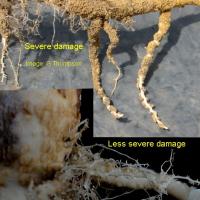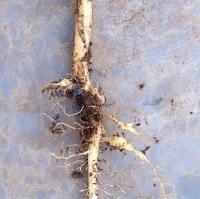Diagnosing clubroot in canola
Clubroot is caused by a soil-borne fungus that only affects plants in the Cruciferae family including canola,mustard, wild radish, wild mustard, wild turnip and vegetable brassicas. This is a serious disease but damage in WA is presently mild and infrequent.
What to look for
- Wilted stunted plants with yellowing leaves
Paddock
- Roots of affected plants become malformed and show galls that may be either spherical or spindle shaped.
- The galls are at first firm and white but become soft and greyish brown as they mature and decay.
- Restricted water and nutrient availability leads to stunted plants that wilt readily, may appear nutrient deficient and ripen prematurely
Plant
What else could it be
| Condition | Similarities | Differences |
|---|---|---|
| Diagnosing Group I herbicide damage in canola | Firm white root nodules | Distorted foliar and reproductive parts; nodules remain firm and white. |
Where did it come from?

Contaminated soil
- Resting spores of the fungus can survive in soil for many years, even in the absence of a susceptible host.
- Paddocks mainly become infected by the movement of soil on cultivation equipment Infection can occur at any stage of growth and is restricted to the roots.
- In the presence of susceptible roots, resting spores germinate and release tiny motile spores that swim in free water to the surface of the rootlets, penetrate and form a fungal colony inside the root cells.
- Infected cells enlarge and divide rapidly, resulting in the galls.
- Late in the season, resting spores develop in the infected roots and are released into the soil as the galls decay.
Management strategies
- Fungicides are ineffective. In the Australian vegetable brassica industry several methods of control have been developed that may be useful for oilseed brassicas.
- Five year rotation: Infested paddocks are kept free of susceptible crops and weeds for at least 5 years, to allow sufficient natural decay of the long-lived spores.
- Equipment movement: Do not move cultivating equipment from infested to non- infested areas before thoroughly cleaning the equipment.
- Liming: Clubroot thrives in acid soils.Liming to increase soil pH (6.5 to 7 in calcium chloride) has been successful for vegetable brassicas but would be cost prohibitive in most canola areas.
Where to go for expert help
Page last updated: Thursday, 16 April 2015 - 1:18pm



